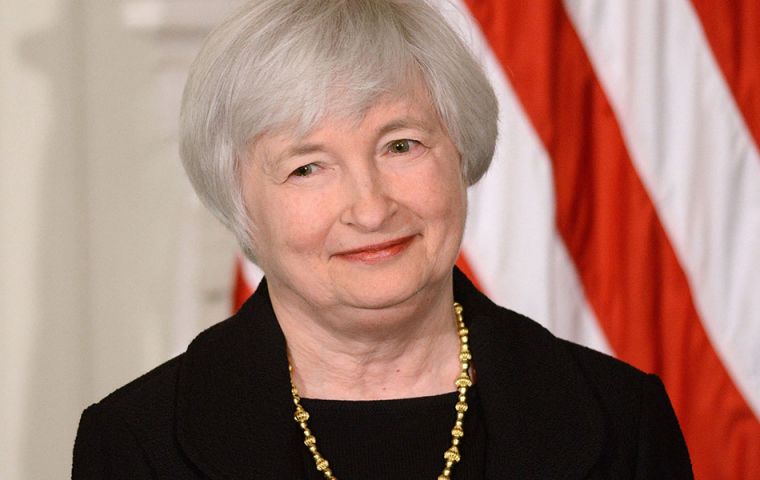MercoPress. South Atlantic News Agency
Fed leaves rate unchanged but will begin selling assets “relatively soon”
 Janet Yellen, chair of the Federal Reserve
Janet Yellen, chair of the Federal Reserve Leaders of the U.S. central bank said Wednesday that they were holding their benchmark lending rate at a low level — in a range between 1 and 1.25% — for the time being. Federal Reserve officials said in a report issued after their two-day policy meeting that the world's largest economy was growing at a “moderate” pace and the job market was improving, but that inflation remained a bit low.
The chief economist of Stifel Fixed Income, Lindsey Piegza, said the Fed appeared eager to raise interest rates back to a more “normal” level and might well approve an increase at its next meeting in September. Sara Johnson of IHS Markit said the next rate hike likely would be in December.
Fed officials cut short-term interest rates to nearly zero during the 2007-09 financial crisis to boost investment and growth. They said the recovering economy no longer needed so much help, so they have been gradually raising interest rates and are expected to boost them further in the future.
Piegza said keeping rates too low for too long might prompt investors to seek better returns by putting money into excessively risky areas. During the recession, the Fed also tried to boost growth by cutting long-term interest rates, with a complex program that involved purchasing huge amounts of securities.
Fed officials said they would keep these assets for the time being but indicated they would begin selling them off “relatively soon.” Fed officials have said they will take care to reduce these assets in a gradual way that will not disrupt markets.
The FOMC release stated the following:
Information received since the Federal Open Market Committee met in June indicates that the labor market has continued to strengthen and that economic activity has been rising moderately so far this year. Job gains have been solid, on average, since the beginning of the year, and the unemployment rate has declined. Household spending and business fixed investment have continued to expand. On a 12-month basis, overall inflation and the measure excluding food and energy prices have declined and are running below 2%. Market-based measures of inflation compensation remain low; survey-based measures of longer-term inflation expectations are little changed, on balance.
Consistent with its statutory mandate, the Committee seeks to foster maximum employment and price stability. The Committee continues to expect that, with gradual adjustments in the stance of monetary policy, economic activity will expand at a moderate pace, and labor market conditions will strengthen somewhat further. Inflation on a 12-month basis is expected to remain somewhat below 2 percent in the near term but to stabilize around the Committee's 2 percent objective over the medium term. Near-term risks to the economic outlook appear roughly balanced, but the Committee is monitoring inflation developments closely.
In view of realized and expected labor market conditions and inflation, the Committee decided to maintain the target range for the federal funds rate at 1 to 1-1/4 percent. The stance of monetary policy remains accommodative, thereby supporting some further strengthening in labor market conditions and a sustained return to 2 percent inflation.
In determining the timing and size of future adjustments to the target range for the federal funds rate, the Committee will assess realized and expected economic conditions relative to its objectives of maximum employment and 2 percent inflation. This assessment will take into account a wide range of information, including measures of labor market conditions, indicators of inflation pressures and inflation expectations, and readings on financial and international developments. The Committee will carefully monitor actual and expected inflation developments relative to its symmetric inflation goal. The Committee expects that economic conditions will evolve in a manner that will warrant gradual increases in the federal funds rate; the federal funds rate is likely to remain, for some time, below levels that are expected to prevail in the longer run. However, the actual path of the federal funds rate will depend on the economic outlook as informed by incoming data.
For the time being, the Committee is maintaining its existing policy of reinvesting principal payments from its holdings of agency debt and agency mortgage-backed securities in agency mortgage-backed securities and of rolling over maturing Treasury securities at auction. The Committee expects to begin implementing its balance sheet normalization program relatively soon, provided that the economy evolves broadly as anticipated; this program is described in the June 2017 Addendum to the Committee's Policy Normalization Principles and Plans.
Voting for the FOMC monetary policy action were: Janet L. Yellen, Chair; William C. Dudley, Vice Chairman; Lael Brainard; Charles L. Evans; Stanley Fischer; Patrick Harker; Robert S. Kaplan; Neel Kashkari; and Jerome H. Powell.




Top Comments
Disclaimer & comment rulesCommenting for this story is now closed.
If you have a Facebook account, become a fan and comment on our Facebook Page!